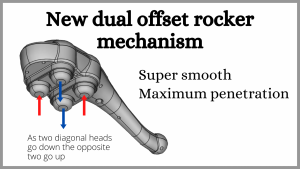Self massage and trigger point therapy for tennis elbow
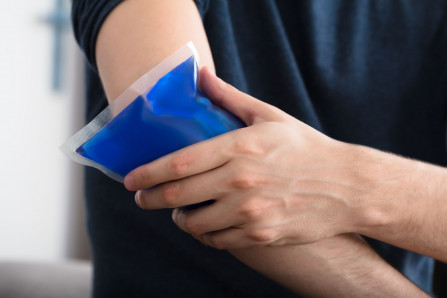
Tennis elbow is too often treated poorly
Tennis elbow is considered a difficult condition and too often does not respond to treatments, but this does not have to be. As I discussed in our article Trigger points and tennis elbow: cause, diagnosis and treatment the main reason for these poor results is that a major cause of abnormal tension in the forearm muscles is usually ignored. This results continued tension which pulls on the injury while it is trying to heal.
There is a better way
The way to successfully treat tennis elbow is by focusing on relieving the abnormal tension in forearm muscles, relieving the abnormal stress on the injury, allowing it to heal normally. This can be done with the simple self massage and trigger point therapy techniques.
In this article I’ll briefly go over how tennis elbow forms and why most treatments fail, then show you the simple massage and trigger point techniques plus basic tennis elbow management strategies.
CONTENTS
What is tennis elbow
What causes tennis elbow
Basic home massage and trigger point therapy management of tennis elbow
The self massage and trigger point therapies
Management of tennis elbow
Things to avoid
Tennis elbow prevention strategies
Professionals
References
What is tennis elbow (lateral epicondylitis)
Tennis elbow is the irritation or injury to the outside of the elbow where many of your forearm muscles are attached. This attachment is called the lateral epicondyle so the technical name is lateral epicondylitis. The condition is common in tennis players, hence the name tennis elbow, but it can be caused by any repetitive activity involving forearms and gripping. It is even a common problem in those continually using a computer.
What causes tennis elbow
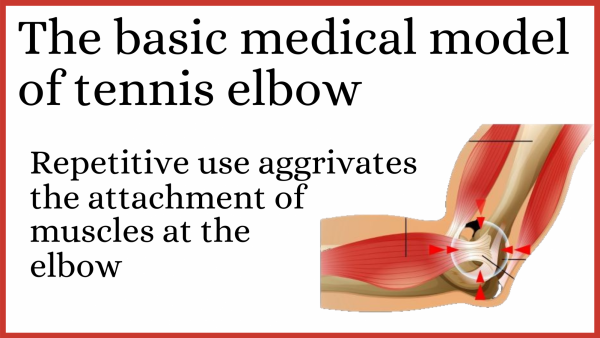
The doctors’ view
Most doctors and articles on tennis elbow will show you a diagram like this and tell you that repetitive activities create stress on the attachment of the muscles at the lateral epicondyle (outside of your elbow) causing irritation, leading to inflammation and injury. They will blame slow healing on a buildup of scar tissue causing further irritation (1–3).
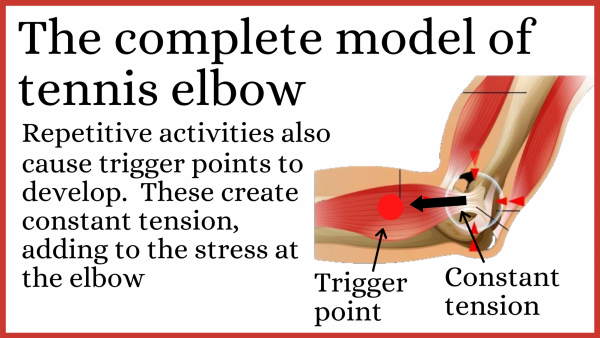
What they ignore
What they ignore is that the overuse of the muscles causes them to tighten and develop trigger points (which cause further tightness) (4–8). This tightness creates extra tension on the attachment at the lateral epicondyle. To put it simply, what you end up with is the injury at the epicondyle trying to heal while the abnormal tension continues to pull on it. Treating professionals will address the injury with rest, medications or therapies, while completely oblivious to this tension (2,3).
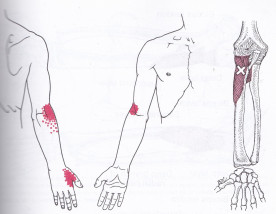
In addition, trigger points can refer pain to the elbow, which can add to or be confused with tennis elbow.
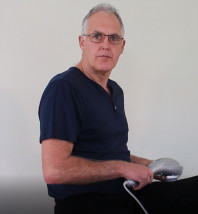
Dr Graeme’s comments
This is something I’ve seen way too much of in 27 + years as a chiropractor. What starts off as a fairly easy problem to deal with it is treated ignoring this tension and doesn’t get better. My wish here is you learn good ways to help take care of your tennis elbow yourself, but also that you be able to avoid the inappropriate treatment and it’s pitfalls. Although you will be able to do a lot of this yourself, please keep in mind that this is for general information only. For specific advice you will need to discuss with a professional familiar with your needs. The advice here is basically what I’d give a patient once I’d determined that it was appropriate.
Basic home massage and trigger point therapy management of tennis elbow
In this section I’ll go over the following.
- To help determine if you have tennis elbow and what you need, I’ll go over how tennis elbow is diagnosed and the basic tests to work out if abnormal forearm muscle tension and/or referred pain from trigger points is/are involved.
- The basic self massage and trigger point therapies
- Basic tennis elbow management
- Some things to avoid
- Tennis elbow prevention strategies
How is tennis elbow diagnosed (do you have tennis elbow)
Lets look at how tennis elbow is diagnosed. The tests are something simple you can do yourself, but please discuss them with a professional.
Symptoms of tennis elbow
The symptoms of tennis elbow are pain at the outside of your elbow, aggravated by activities such as bending back your wrist or fingers, or by gripping.
Simple tests for tennis elbow
There are two basic tests a doctor will do to diagnose tennis elbow.
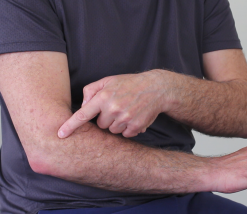
Examining for tenderness
Examine the outside of your elbow. It will be very tender at the bony bump (lateral epicondyle) and for 1-2 cm towards your wrist (the tendon).
Provocation tests
There are a couple of tests with the impressive sounding names Mills and Cozens tests, but these are basically I) bending your wrist forward to tighten the muscles at the back of your forearm that attach to the lateral epicondyle, and ii) bending the wrist back the other way against resistance. These pull on the area injured in tennis elbow, so if they cause pain it is considered positive.
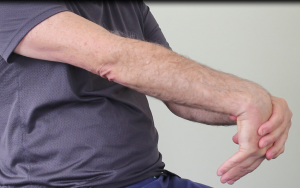
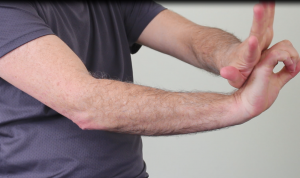
Tests for trigger point involvement
Simple palpation
This is simply examining your forearm muscles for trigger points. This can be done using the technique demonstrated in our video on forearm muscles. If you find trigger points they will certainly be causing the muscles to be tight, so they will be involved. If pressing on them causes your elbow pain it also shows that they are indirectly causing pain as well.
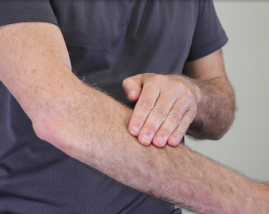
Tension relief test
This simply tests what happens if the tension caused by trigger points is temporarily removed.
Step one:
Try gripping something or bending your wrist back to reproduce the pain, then examine the outside of your elbow for tenderness.
Step two:
Temporarily relieve the tension in your forearm muscles by treating the trigger points using either of the two methods shown below.
Step three:
Re-test your elbow by doing the activity that previously caused pain and by examining the side of your elbow. If the activity is less painful or the tenderness at the side of your elbow is reduced it is a sign that tension due to trigger points is contributing to you tennis elbow.
The self massage and trigger point therapy
Basic principles
For this you need to forget any advice you’ve seen about massaging the sore elbow to stimulate blood flow and break up scar tissue. That is little use and more often than not stirs up the problem. Instead you will be focusing on:
- relieving abnormal tension, and
- treating trigger points that refer pain which mimics and adds to tennis elbow pain
The muscles
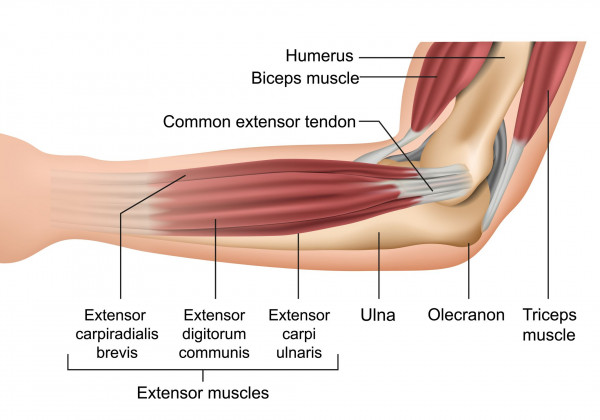
The main muscles
There are many muscles at the back of your forearm from your elbow to your wrist. These are very important because:
- most attach to the lateral epicondyle so if they are tight they will stress the injury, and
- most have trigger points that refer pain to your elbow
Other muscles
There are several other muscles that are important. Some (eg. triceps) can have trigger points that can refer pain to your elbow. Others often work together with your forearm muscle to perform tasks. If there are issues with some muscles others are forced to compensate. For simplicity consider all the muscles of your arm.
The techniques
In this guide I’ll show you two self massage and trigger point therapies you can easily do at home:
- a simple manual massage technique that needs no special equipment, and
- vibration massage
Basic manual massage
Forget the special patterns, rubbing across fibres and the other secret sauce recipes you see advised for massaging tennis elbow. There’s no real need for a lot of it, some is actually harmful, and the basic technique I’ll show you works just fine. You can use this technique on any muscles you can comfortably access yourself.
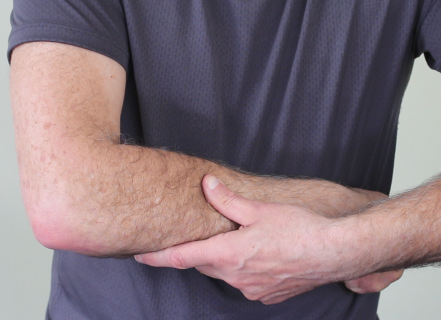
What I’ll get you to do is imagine your forearm muscles are like old sponges filled with gunk. Lubricate your forearm, then using light to moderate pressure with your thumb move slowly from your wrist to your elbow like you are squeezing out the gunk.
- Massage like this must be done towards your heart because your lymphatic (drainage) vessels and veins have one way valves. Massaging the other way would be trying to force fluids the wrong way through these one way valves.
- Stop two cm before the painful bony bump at your elbow, otherwise you risk further damaging the healing injury.
- Work systematically to cover all the muscles
- Repeat the process using gradually more pressure to penetrate deeper.
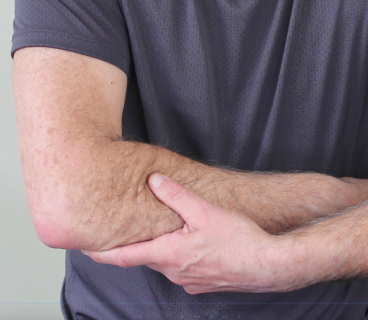
Trigger point therapy
This basic massage technique can be easily modified to become a highly effective trigger point therapy. As you move along the muscle you may find part that is particularly tight, and some may contain a tender lump that possibly refers pain. These are possible trigger points. When you get to these tight spots or lumps stop and maintain pressure for 5-10 seconds before moving on.
Vibration massage (Our recommendation)
Vibration massage is widely used by professionals to provide massage and to treat trigger points. It is done by simply placing the vibration massager over the trigger point allowing the vibrations to penetrate and have their effect. Because it does not require penetrating pressure it is relatively safe, and because no special skills are required it is far easier to self apply.
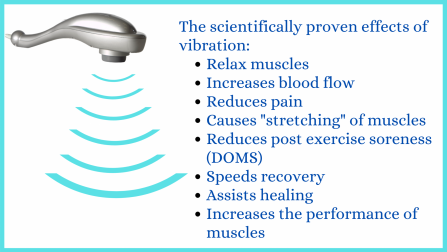
Why vibration massage works
As shown in this diagram vibration penetrates your muscles and helps reduce spasm, muscle tightness, restricted blood flow, and any build up of toxic wastes. For more information please see our guide The scientifically proven effects of vibration massage- with clinical applications.
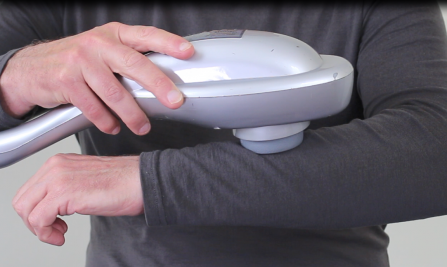
How to use vibration massage
Using vibration massage is extra-ordinarily easy. I ask that before using this therapy you check our vibration massage usage guide , but basically all you need to do is place the vibration massager on the muscle over muscle to be massaged or the trigger point and let the vibrations penetrate for 30-60 seconds. This can easily be repeated every day. Please note that you need a proper effective vibration massager. As discussed in our article Should I get a massage gun or a vibration massager most of the common massage guns and percussion massagers will be ineffective.
There are two basic patterns you can use to massage using a vibration massager. As for the manual massage don't apply directly to the painful elbow.
Systematic
Use a systematic pattern massaging one part at a time so you cover the whole muscle.
Specific
Examining the muscle and working on any problems found.
How to choose a vibration massager
For how to choose an quality massager that will do a great job and that you will be extremely happy with please see our article How to choose a massager, or you can go straight and check out our economical, easy to use professional standard machines: the General Purpose Massager or our Ultimate Quad Head Massager.
Basic management of tennis elbow
Like most injuries the recovery of tennis elbow needs to be considered in three phases
The acute phase
This is when the injury is very inflamed, and the goal is to settle it down. You will recognise this because the elbow will be constantly sore and activities may cause sharp pain.
- The safest therapy is to rest and apply ice to the elbow for 5 minutes each hour.
- Massage to the elbow at this stage would potentially cause further injury. However, the massage we recommend is only to the muscles so it should be safe. It will actually help because it will help take the tension off the injury.
- We see exercises recommended to relieve tennis elbow pain. Exercises stress the injury, so this is about as appropriate as advising you to go for a run to relieve your sprained ankle (very dumb).
The healing phase
During this phase much of the soreness will have gone, but it will still be tender if you press upon it. During this phase your massages and trigger point therapies will be very important to continue to de-stress the injured area. Activities can gradually be re-introduced.
The rehabilitation phase
For minor tennis elbows this will not be needed. However, if the condition has been there a long time muscles and joint tissues may have deteriorated. Once the injury has healed a program of stretching and exercises will be needed to restore them to normal.
Things to avoid

Graeme’s comments
Over 27+ years as a chiropractor these are the three things stop tennis elbows getting better and potentially do harm.
Ignoring the tension caused by abnormal forearm muscles.
As I’ve said, too often we get treatment directed at the elbow, completely oblivious to the fact that abnormal tension in the forearm muscles continues to stress the injury.
Stirring up the elbow
While the elbow is trying to heal we get things like needles and cross friction massage causing damage.
Exercises and stretches to relieve the pain
By definition exercises and stretches pull on the injury that is trying to heal. In the case of stretching there may be sort term stress on the injury while doing the stretch followed by temporary reduction in stress due to the muscle being stretched. The benefits may outweigh the risks, but you could just as easily do a lot more damage. Why do it when simple massage and trigger point therapy will relax the muscle at least as well, but with no adverse effects.
Tennis elbow prevention strategies
The beauty of the simple techniques I’ve shown you is that they can be used very early to stop tennis elbow problems becoming bad. However, why not use them as a prevention strategy? We know that if you do things that repeatedly use your forearm muscles they will tighten, develop trigger points then eventually develop tennis elbow. So, if you are a trades person, work at a computer, or even play tennis you could do these home massage and trigger point therapies to keep your muscles healthy and avoid problems.
Other self massage and trigger point therapy articles
If you found this useful please check out our other self massage and trigger point therapy articles.
- Self massage and trigger point therapy for headaches and migraines
- Massage And Trigger Point Therapy For Low Back Pain, With Self Help Options
- Massage And Trigger Point Therapy For Calf Pain, With Self Help Options
- Massage And Trigger Point Therapy For Shoulder Pain, With Self Help Options
- Trigger Point Therapy For Fibromyalgia: Inc. Self Help Advice
- Self Massage For High Blood Pressure
- Self Massage For Anxiety
Professionals
DrGraeme massagers were originally built by Dr Graeme for use in his clinic, and to prescribe to his patients for additional self use at home. Now these are used by colleagues and other professionals for similar purposes. If you are a professional and wish to know more about this therapy, or possibly get a sample massager to trial please check out our practitioner page.
References
- Trivedi P, Sathiyavani D, Nambi G, Khuman R, Shah K, Bhatt P. Comparison of active release technique and myofascial release technique on pain, grip strength & functional performance in patients with chronic lateral epicondylitis. Int J Physiother Res. 2014;2(3):488–94.
- Smidt N, Windt DAWM Van Der, Assendelft WJJ, Devillé WLJM, Bos IBCK. Corticosteroid injections , physiotherapy , or a wait-and-see policy for lateral epicondylitis : a randomised controlled trial. Lancet. 2002;359:657–62.
- Johnson GW, Cadwallader K, Scheffel SB, Epperly TEDD. Treatment of Lateral Epicondylitis. Am Fam Physician. 20[07;(76):843–50.
- Celik D, Mutlu EK. Clinical implication of latent myofascial trigger oint topical collection on myofascial pain. Curr Pain Headache Rep. 2013;17(8).
- Bron C, Dommerholt JD. Etiology of myofascial trigger points. Curr Pain Headache Rep. 2012;16(5):439–44.
- Zhuang XQ, Tan SS, Huang QM. Understanding of myofascial trigger points. Chin Med J (Engl). 2014;127(24):4271–7.
- Aggarwal A, Daniel J, Palekar TJ. Prevalence of Myofascial Trigger Points in Brachioradialis, Biceps Brachii, Triceps Brachii, Supinator and Extensor Carpi Radialis Brevis in Lateral Epicondylitis. Indian J Physiother Occup Ther - An Int J. 2020;(1):14–8.
- Fernández-Carnero J, Fernández-De-Las-Peñas C, De La Llave-Rincón AI, Ge HY, Arendt-Nielsen L. Bilateral myofascial trigger points in the forearm muscles in patients with chronic unilateral lateral epicondylalgia: A blinded, controlled study. Clin J Pain. 2008;
We are continually adding more information on research and uses. Subscribe below to have us email them to you "hot off the press".

About Dr Graeme
Several years ago Dr Graeme, a Chiropractor practicing in Victoria, Australia was looking for a serious hand held massager his patients could use at home to get the extra quality massage they needed. The ones he found in the shops and on-line for home use looked nice but were not serious, and... read more

